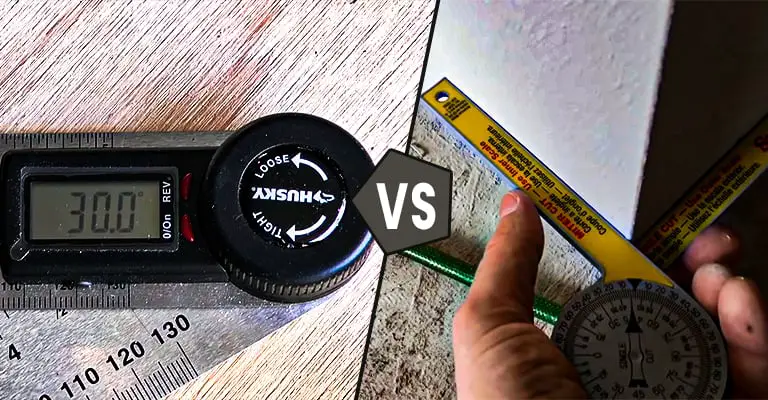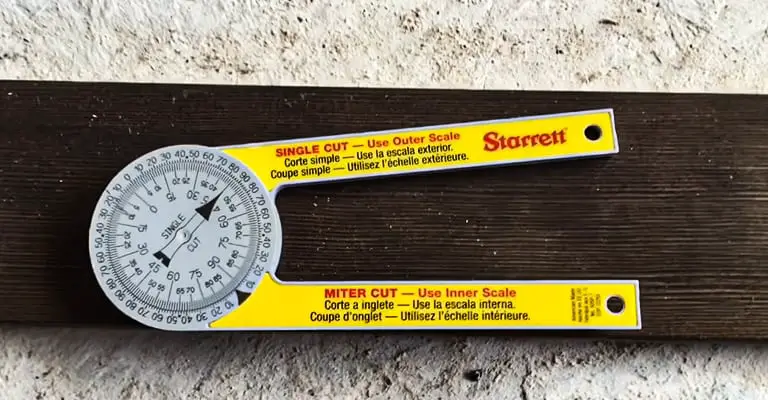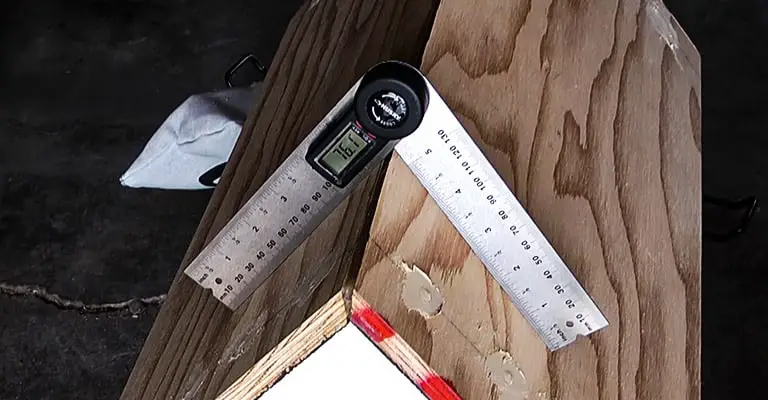I love creating free content full of tips for my readers, you. I don't accept paid sponsorships, my opinion is my own, but if you find my recommendations helpful and you end up buying something you like through one of my links, I could earn a commission at no extra cost to you. Learn more
In the world of carpentry and woodworking, an angle finder is an infamous and essential tool. Despite being used mostly in those two fields, an angle finder can measure the angle between pretty much anything that has two straight surfaces connected with each other. As a result, its usage has spread across other fields as well.
While the two fields mentioned above do not require pinpoint accuracy, engineers have decided to challenge the classic analog angle finder with a competitor, the digital angle finder. In this article, we try to unfold all the secrets of these two types of tools and which one could be more beneficial to you.

In this post we'll cover:
The Analog Angle Finder
Simply put, there are no electronic devices attached to this kind of angle finder and this is what makes them analog. Some analog angle finders use the two-arms model and some use the rotating vial model. There are no digital screens to display the degree in both of them.
The Digital Angle Finder
It is impossible for a digital device to not be electric. A digital angle finder is no different. There is, normally, an LCD screen to display the angle. The popularity of a digital angle finder has dominated more and more because of the precision of the readings of angles.
Digital vs Analog Angle Finder – Similarities and Dissimilarities
Comparing these two tools is more of a cliché, but we did it nonetheless. From the basic features of every tool to the advanced, in-depth analysis, and the extra features, we left no stones unturned. You will surely get a clear idea about these two and hopefully, that will help you decide which one to go for, on your next purchase.Outlook and External
There are a variety of models for both types of angle finders. Their external and structure make some of them easy to work with while the other is just a hassle for most users. We will explain to you two of the most common models from both types. Two-armed Analog Angle Finder These angle finders normally have two metal or plastic arms joined with each other at one end. At the junction, there is a circular, 360degree angle sticker with a marker. When you spread the arms, the marker on the sticker moves along the circular sticker indicating the angle created between the two arms. Some angle finders have a protractor attached to the frame. While using a protractor angle finder you’ll observe markings of 0 degrees to 180 degrees. Although the concept sounds peculiar, these work pretty well. But a digital protractor would certainly be a better choice. Rotating Vial Analog Angle Finder In this design, a 360degree angle sticker is put inside a circular plastic box. The box is filled with a special type of vial and an indicating arm is fixed there. This arrangement is fixed on some rigid plastic frame. When you rotate the tool along its sides, the vials allow the indicating arm to move and point at the angle reading. Two-armed Digital Angle Finder It is similar to the externals of a two-armed analog angle finder except for the 360degree sticker part. There is a digital device and a digital screen at the junction. It displays the exact angle created within the separation of the two arms. Non-armed Digital Angle Finder As the name suggests, there are no arms in this one. It is like a square box with a digital screen on one side. These things often come with one edge being magnetized for better grip on metal surfaces. When you rotate the device along its side, you get an angle reading on the screen.Mechanism of an Analog Angle Finder
Analog angle finders rely on the displacement of the indicating arm or pointer. Be it on the 360degree angle sticker or the rotating vial, there are no electric actions or devices involved in creating those angles. Just the movements of the arms and reading from the sticker.Mechanism of a Digital Angle Finder
Digital angle finders have multiple electric devices including but not limited to circuits, transistors, a digital screen, and a special device called the rotary encoder. This rotary encoder is an electro-mechanical device that can measure the angular displacement of a shaft and convert the measurement into a digital signal. Other electrical devices help to convert the digital signal into the degrees, which we understand. Lastly, this reading of degrees is transmitted and displayed on the digital screen. For the two-armed angle finders, the angular displacement of the shaft is measured from a previously fixed arm. And for the square-shaped version, the shaft is set on a resting position inside the box. When the device is rotated along its side, the shaft moves, and the reading is obtained.Accuracy of an Analog Angle Finder
Naturally, the reading that you obtain from an analog angle finder is not as accurate as of the digital one. Because after you have measured an angle, it is finally going to be you who will read the numbers from the angle sticker. Although your eyes work perfectly and you can read numbers from a table fine, here’s where it gets tricky. There are very small angle measurements on these stickers which you won’t be able to identify, because you’ll be confused at the tenth part of the degree. Simply, you can’t measure up to the tenth of a degree.Accuracy of a Digital Angle Finder
A digital angle finder wins this battle. That’s because you don’t have to identify and take the readings from an angle sticker. You can get the angle reading up to the tenth of a degree just from the screen. It’s that simple.Longevity of an Analog Angle Finder
You don’t have to worry about the arms because, usually, they will not decay over time. The same goes for the vial. However, the arms can break if you don’t use it properly. The same can be said for the plastic that holds the vial too. If the plastic is of bad quality, then it might break down if it falls from a medium height like a table or so. Also, for the two-armed one, its sticker is a piece of paper with a plastic coating on top. There is a possibility of it getting scratched or damaged.Longevity of a Digital Angle Finder
Electronic devices have that risk of becoming bad on the inside apart from mechanical damages. This is also true for a digital angle finder. The arms may break and so can the screen if you are not careful. But the most important thing regarding the longevity of a digital angle finder is perhaps the battery. You have to change the battery now and then to run it. This is an area where the analog angle finder wins over the digital one.Lockable Arms
This is a feature that is found on both types of devices. Only the two-armed version of the angle finders can benefit from this feature. When you measure a corner using an angle finder arms, you can lock the arms and move it here and there before taking the reading.Storing Measurements
Nowadays, some digital angle finders have the exclusive feature of storing readings. You can take multiple readings at a time and without the need of noting them down on a paper. Instead, you can store those values on your angle finders and access them later on. This could be useful to some users.Cost
A digital angle finder offers more features and versatility. So, its price on the market is higher than an analog angle finder. If you are low on a budget, an analog angle finder may be a choice to explore for you.Conclusion
Needless to say, a digital angle finder beats an analog angle finder on most of the decisive cases like precision, ease of access, etc. Nevertheless, some users might consider the analog version because of some reasons. One of those reasons could be that the user is not looking for precision to the tenth of a degree. It could be perfectly valid for someone who has a specific job that does not require much accuracy. People who don’t use an angle finder frequently could also go for the analog angle finder because they don’t need to worry about changing the battery, or the device becoming faulty due to not using it. However, for the people who need to work with angles regularly and precision is an important factor, they should go for the digital angle finder. Since they’ll be using it regularly, the machine will be up and running if they take care of it.I'm Joost Nusselder, the founder of Tools Doctor, content marketer, and dad. I love trying out new equipment, and together with my team I've been creating in-depth blog articles since 2016 to help loyal readers with tools & crafting tips.
